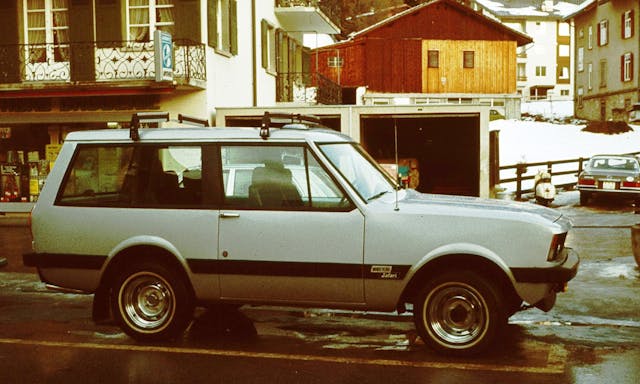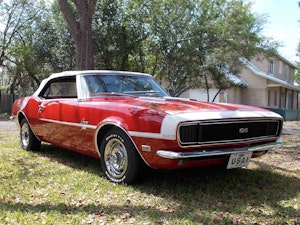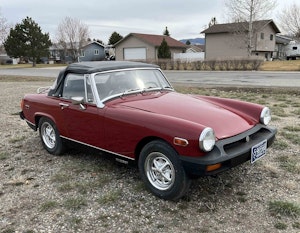Media | Articles
The Rise and Fall of Monteverdi Automotive
In 1967, when Peter Monteverdi returned Switzerland to the automotive manufacturing map, the world had Enzo Ferrari to thank, yet again.
In company with Ferruccio Lamborghini and Giotto Bizzarrini, Monteverdi fed his frustration with Ferrari into automotive fertility. Reports are mixed on the source of the angst—some saying it started with Enzo crushing Monteverdi’s dream to drive for the Scuderia, while others suggest it was due to Enzo’s demands surrounding his Ferrari franchise. Whatever the reason, Peter Monteverdi took the bold decision to create his own car company, largely to spite Ferrari. The firm that bore his name went on to create luxury GTs, sports cars, and even an SUV, long before the latter became the norm in Europe.
Monteverdi’s stint in the automotive realm kicked off when he took over running his father’s garage business in 1956. Monteverdi senior ran a small automotive repair shop in the Swiss town of Binningen, just outside Basel. Rather than simply continuing his late father’s work, Monteverdi junior, then just 22 years old, had higher aspirations.
Obsessed with speed and motor racing—he built his first special as a teen from parts pillaged from a wrecked Fiat 1100—Monteverdi’s privateering in motorsport eventually led him to Maranello. There he bought several Ferraris, racing them in hill climbs and even endurance competitions such as the Nürburgring 1000Km. His success and ambition brought him to the attention of Enzo Ferrari, with the young Monteverdi turning his association with the prancing horse into an advantage. He managed to secure Swiss distribution rights for the brand in 1957, making him, at 23, the world’s youngest official Ferrari importer at the time.

And times were good in Binningen, where the young Monteverdi, expanding to new premises in 1961, added further premium marques to his dealership’s stock and trade, including Lancia, Jensen, Bentley, Rolls-Royce, and, eventually, BMW. Continuing to juggle selling premium sports cars and GTs during the week with racing machines of his own design on the weekend, Monteverdi ultimately took building competitive Formula Junior race cars—which he sold across the world under the MBM brand—to its logical conclusion, debuting Switzerland’s first Formula 1 racer at the non-championship 1961 Solitude Grand Prix. As a keen driver, Monteverdi couldn’t resist the chance to compete; however, a subsequent crash at Hockenheim almost proved fatal and ultimately ended his competition dreams.
Marketplace
Buy and sell classics with confidence
After his recovery and retirement from racing, Monteverdi faced another hurdle: Enzo Ferrari’s demands. Apparently, old man Ferrari stipulated that Monteverdi buy 100 new Ferraris—and pay for them up front—to retain his import privileges. Clearly furious at this presumption, Monteverdi refused and duly lost his franchise. Deciding, just as Ferruccio Lamborghini had, that the best form of revenge was to make his own cars to rival Ferrari’s, Monteverdi turned his attention and considerable enthusiasm toward the drawing board, with his first road-car creation arriving in 1967.
Christened the Monteverdi High Speed 375 S, this big GT came with bespoke bodywork, designed and hand-built by Carrozzeria Frua (later tweaked by Fissore), with power courtesy of Chrysler’s 440-cubic-inch V-8. The High Speed won many an admirer upon its debut at the 1967 Frankfurt motor show; it was also the first Swiss-made model to be presented for three decades.




Naturally, the level of luxury and performance Monteverdi offered didn’t come cheap, with first-time 375 S owners having to cough up an eye-watering $28,000. To put that into perspective, a new Aston Martin DB6 cost $13,900, with a Ferrari 275 GTB/4 $16,750. Mind you, for that hefty wedge, you did get 375 hp (hence the name; the 450-hp 426 Hemi V-8 was an option) and a claimed 0–60 time of just over 6 seconds. The High Speed’s top speed of 152 mph was more than enough to raise a few eyebrows in Maranello, yet Enzo was likely reassured by the 375’s use of an American V-8, one shared with the Jensen Interceptor. While easier to maintain and more reliable than, say, a British six-pot or rival Italian V-12, the large and lazy American motor lacked the glamor or wailing high-rpm thrills of either, with peak power delivered at a leisurely 4700 rpm. Rather than a hindrance, however, attainable torquey performance was seen as a benefit for many a fan of mid-century Grand Touring.
It wasn’t all good news, however, with early quality issues reported in period publications, but it didn’t stop Monteverdi expanding the range. Lacking capacity, Frua made way for Fissore, with the latter Savigliano-based carrozzeria developing the 2+2 375 L as well as a four-door saloon, the 375/4, plus a convertible, the 375 C, as the carmaker entered the 1970s.



Fuel crisis concerns effectively outlawed large-displacement GTs by the mid-1970s, with Monteverdi’s creations far from immune. The last of what is thought to be just over 200 of all variants of the 375 was delivered in 1975. By that time, however, two very different Monteverdi creations were either already on sale or were on the drawing board. The first was the 1970 Monteverdi Hai 450SS mid-engined supercar. Looking like a prototype Alpine A310—but with a far more exciting 450-hp Chrysler Hemi in the middle—the Hai (German for “shark”) was meant to catapult Monteverdi to the dizzying heights of exotic car manufacture. With just two of these 180-mph (claimed) machines thought to have been produced, however, it failed utterly. This was quite a missed opportunity, considering the subsequent success of the similarly themed De Tomaso Pantera that followed just a year later, and the Hai has since slipped into obscurity.


Monteverdi was down, but far from out, picking himself up and spotting a niche in an as-yet untapped market: luxury SUVs. In 1976, the Monteverdi Safari—based on the International Harvester Scout—was introduced to compete with the likes of the Range Rover (in Europe) and went on to sell well, despite costing more than said Range Rover.



Incidentally, it was Monteverdi who first converted Range Rovers into four-doors, starting in 1980, long before Land Rover ever got around to it. The custom coachwork was handled by Fissore, and Monteverdi also granted them more luxurious interiors. Converted Range Rovers were then sold via select Land Rover dealerships and were even backed by factory warranties. Even this lucrative contract work wasn’t enough to keep Monteverdi afloat, however, and Monteverdi Automotive closed its doors in 1982.


Peter Monteverdi staged a comeback a decade later, following his Formula 1 foray in 1990, but demand for a resurrected Hai—even one powered by a 650-hp F1 engine—proved to be non-existent.
Monteverdi passed away in 1998, leaving an indelible mark on motoring history. The firm that bore his name blazed a trail, attempted to break Ferrari’s dominance of the luxury GT market, competed in the top tier of motorsport, twice, and has resulted in some of the most highly collectible and coveted classic cars on the market. Not bad for a former mechanic from a small Swiss town.





























Some very nice designs here. Funny how many companies have their start in being pissed off with Ferrari.
Thanks for writing this story. Monteverdi made some beautiful machines. I have a Dinky toy version of one of them.
I remember a Matchbox as well. Blue, I think.
Interesting how the author skipped over discussing the Sierra…I’m sure Monteverdi wished they had skipped the Sierra, too.